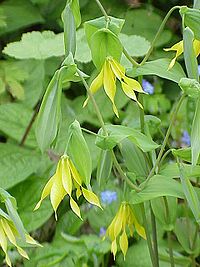Uvularia grandiflora
| Habit | herbaceous
| |
|---|---|---|
| Height: | ⇕ | 12 in"in" can not be assigned to a declared number type with value 12. to 24 in"in" can not be assigned to a declared number type with value 24. |
| Width: | ⇔ | 12 in"in" can not be assigned to a declared number type with value 12. to 24 in"in" can not be assigned to a declared number type with value 24. |
| Bloom: | ❀ | late spring |
| Exposure: | ☼ | shade |
|---|---|---|
| USDA Zones: | 3 to 9 |
|
Uvularia > |
Large-flowered bellwort (Uvularia grandiflora) is a plant in the family Colchicaceae, native to eastern North America.
It blooms in May, producing large yellow flowers. The top parts of the plant tend to bend downward due to the weight of the leaves and flowers. The light green stems are round, glabrous, and glaucous and the leaves are perfoliate since the stem appears to come through the leaves at the base.
Large flowered bellwort are different from Uvularia sessilifolia in that the leaves of U. sessilifolia grow from the stem and its flowers are smaller. U. grandiflora are also different from Uvularia perfoliata, which occurs in Central North America. U. perfoliata has similar large perfoliate leaves like the grandiflora, but the flowers have orange-coloured bumps on the petals.
Bumblebees, Mason bees, Halictid bees, and Andrenid bees feed from the nectar and collect pollen from the flowers. Deer love to eat these plants.
In fall three capsuled ovaries can be observed on some individuals. The seeds have attached food bodies (elaiosome) making it attractive to ants for the redistribution of the seeds.
Its native range extends from the Appalachian mountains west to the Dakotas, north to Manitoba and Quebec, and south to Louisiana and Georgia.[1]
Read about Uvularia grandiflora in the Standard Cyclopedia of Horticulture
|
|---|
|
Uvularia grandiflora, Smith. Sts. 1 – 1 1/2 ft. high, with 1 or 2 lvs. below the fork: lvs. oblong, oval or ovate, somewhat acuminate: fls. pale yellow, 1-1 1/2 in. long; segms. usually smooth on both sides: stamens exceeding the styles: caps. obtusely 3-angled, truncate. May, June. Rich woods, Que. to Minn. south to Ga., Tenn., and Iowa. CH
|
Cultivation
Propagation
Pests and diseases
Varieties
Gallery
References
External links
- w:Uvularia grandiflora. Some of the material on this page may be from Wikipedia, under the Creative Commons license.
- Uvularia grandiflora QR Code (Size 50, 100, 200, 500)
